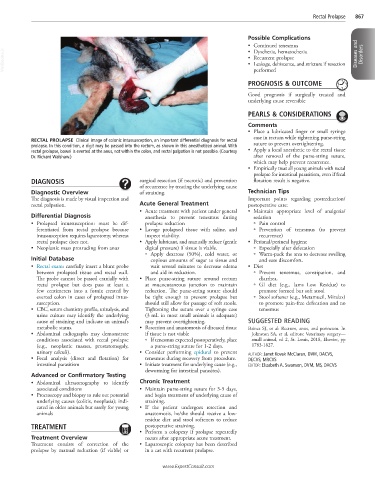Page 1723 - Cote clinical veterinary advisor dogs and cats 4th
P. 1723
Rectal Prolapse 867
Possible Complications
• Continued tenesmus
VetBooks.ir • Recurrent prolapse Diseases and Disorders
• Dyschezia, hematochezia
• Leakage, dehiscence, and stricture if resection
performed
PROGNOSIS & OUTCOME
Good prognosis if surgically treated and
underlying cause reversible
PEARLS & CONSIDERATIONS
Comments
• Place a lubricated finger or small syringe
case in rectum while tightening purse-string
RECTAL PROLAPSE Clinical image of colonic intussusception, an important differential diagnosis for rectal
prolapse. In this condition, a digit may be passed into the rectum, as shown in this anesthetized animal. With suture to prevent overtightening.
rectal prolapse, bowel is everted at the anus, not within the colon, and rectal palpation is not possible. (Courtesy • Apply a local anesthetic to the rectal tissue
Dr. Richard Walshaw.) after removal of the purse-string suture,
which may help prevent recurrence.
• Empirically treat all young animals with rectal
prolapse for intestinal parasitism, even if fecal
DIAGNOSIS surgical resection (if necrotic) and prevention flotation result is negative.
of recurrence by treating the underlying cause
Diagnostic Overview of straining. Technician Tips
The diagnosis is made by visual inspection and Important points regarding postreduction/
rectal palpation. Acute General Treatment postoperative care:
• Acute treatment with patient under general • Maintain appropriate level of analgesia/
Differential Diagnosis anesthesia to prevent tenesmus during sedation
• Prolapsed intussusception: must be dif- prolapse reduction ○ Pain control
ferentiated from rectal prolapse because • Lavage prolapsed tissue with saline, and ○ Prevention of tenesmus (to prevent
intussusception requires laparotomy, whereas inspect viability. recurrence)
rectal prolapse does not. • Apply lubricant, and manually reduce (gentle • Perianal/perineal hygiene
• Neoplastic mass protruding from anus digital pressure) if tissue is viable. ○ Especially after defecation
○ Apply dextrose (50%), cold water, or ○ Warm-pack the area to decrease swelling
Initial Database copious amounts of sugar to tissue and and ease discomfort.
• Rectal exam: carefully insert a blunt probe wait several minutes to decrease edema • Diet
between prolapsed tissue and rectal wall. and aid in reduction. ○ Prevent tenesmus, constipation, and
The probe cannot be passed cranially with • Place purse-string suture around rectum diarrhea.
rectal prolapse but does pass at least a at mucocutaneous junction to maintain ○ GI diet (e.g., Iams Low Residue) to
few centimeters into a fornix created by reduction. The purse-string suture should promote formed but soft stool
everted colon in cases of prolapsed intus- be tight enough to prevent prolapse but ○ Stool softener (e.g., Metamucil, Miralax)
susception. should still allow for passage of soft stools. to promote pain-free defecation and no
• CBC, serum chemistry profile, urinalysis, and Tightening the suture over a syringe case tenesmus
urine culture may identify the underlying (3 mL in most small animals is adequate)
cause of straining and indicate an animal’s may prevent overtightening. SUGGESTED READING
metabolic status. • Resection and anastomosis of diseased tissue Baines SJ, et al: Rectum, anus, and perineum. In
• Abdominal radiographs may demonstrate if tissue is not viable Johnston SA, et al, editors: Veterinary surgery—
conditions associated with rectal prolapse ○ If tenesmus expected postoperatively, place small animal, ed 2, St. Louis, 2018, Elsevier, pp
(e.g., neoplastic masses, prostatomegaly, a purse-string suture for 1-2 days. 1783-1827.
urinary calculi). • Consider performing epidural to prevent AUTHOR: Janet Kovak McClaran, DVM, DACVS,
• Fecal analysis (direct and flotation) for tenesmus during recovery from procedure. DECVS, MRCVS
intestinal parasitism • Initiate treatment for underlying cause (e.g., EDITOR: Elizabeth A. Swanson, DVM, MS, DACVS
deworming for intestinal parasites).
Advanced or Confirmatory Testing
• Abdominal ultrasonography to identify Chronic Treatment
associated conditions • Maintain purse-string suture for 3-5 days,
• Proctoscopy and biopsy to rule out potential and begin treatment of underlying cause of
underlying causes (colitis, neoplasia); indi- straining.
cated in older animals but rarely for young • If the patient undergoes resection and
animals anastomosis, he/she should receive a low-
residue diet and stool softeners to reduce
TREATMENT postoperative straining.
• Perform a colopexy if prolapse repeatedly
Treatment Overview recurs after appropriate acute treatment.
Treatment consists of correction of the • Laparoscopic colopexy has been described
prolapse by manual reduction (if viable) or in a cat with recurrent prolapse.
www.ExpertConsult.com

